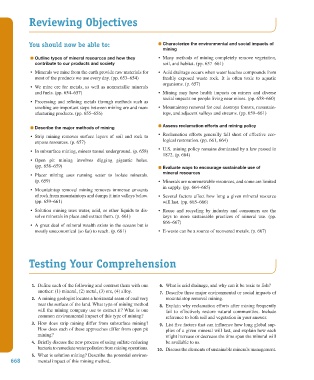Page 669 - Environment: The Science Behind the Stories
P. 669
Reviewing Objectives
You should now be able to: Characterize the environmental and social impacts of
mining
Outline types of mineral resources and how they • Many methods of mining completely remove vegetation,
contribute to our products and society soil, and habitat. (pp. 657–661)
• Minerals we mine from the earth provide raw materials for • Acid drainage occurs when water leaches compounds from
most of the products we use every day. (pp. 653–654) freshly exposed waste rock. It is often toxic to aquatic
organisms. (p. 657)
• We mine ore for metals, as well as nonmetallic minerals
and fuels. (pp. 654–657) • Mining may have health impacts on miners and diverse
social impacts on people living near mines. (pp. 658–660)
• Processing and refining metals through methods such as
smelting are important steps between mining ore and man- • Mountaintop removal for coal destroys forests, mountain-
ufacturing products. (pp. 655–656) tops, and adjacent valleys and streams. (pp. 659–661)
Describe the major methods of mining Assess reclamation efforts and mining policy
• Strip mining removes surface layers of soil and rock to • Reclamation efforts generally fall short of effective eco-
expose resources. (p. 657) logical restoration. (pp. 661, 664)
• U.S. mining policy remains dominated by a law passed in
• In subsurface mining, miners tunnel underground. (p. 658)
1872. (p. 664)
• Open pit mining involves digging gigantic holes.
(pp. 658–659) Evaluate ways to encourage sustainable use of
mineral resources
• Placer mining uses running water to isolate minerals.
(p. 659) • Minerals are nonrenewable resources, and some are limited
in supply. (pp. 664–665)
• Mountaintop removal mining removes immense amounts
of rock from mountaintops and dumps it into valleys below. • Several factors affect how long a given mineral resource
(pp. 659–661) will last. (pp. 665–666)
• Solution mining uses water, acid, or other liquids to dis- • Reuse and recycling by industry and consumers are the
solve minerals in place and extract them. (p. 661) keys to more sustainable practices of mineral use. (pp.
666–667)
• A great deal of mineral wealth exists in the oceans but is
mostly uneconomical (so far) to reach. (p. 661) • E-waste can be a source of recovered metals. (p. 667)
Testing Your Comprehension
1. Define each of the following and contrast them with one 6. What is acid drainage, and why can it be toxic to fish?
another: (1) mineral, (2) metal, (3) ore, (4) alloy. 7. Describe three major environmental or social impacts of
2. A mining geologist locates a horizontal seam of coal very mountaintop removal mining.
near the surface of the land. What type of mining method 8. Explain why reclamation efforts after mining frequently
will the mining company use to extract it? What is one fail to effectively restore natural communities. Include
common environmental impact of this type of mining? reference to both soil and vegetation in your answer.
3. How does strip mining differ from subsurface mining? 9. List five factors that can influence how long global sup-
How does each of these approaches differ from open pit plies of a given mineral will last, and explain how each
mining? might increase or decrease the time span the mineral will
4. Briefly discuss the new process of using sulfate-reducing be available to us.
bacteria to remediate water pollution from mining operations. 10. Discuss the elements of sustainable minerals management.
5. What is solution mining? Describe the potential environ-
668 mental impact of this mining method.
M23_WITH7428_05_SE_C23.indd 668 18/12/14 10:41 AM

